

How to Write ‘Compare and Contrast’ Type of Essay in IELTS Writing Task 2?
In ‘compare and contrast’ type of essay, IELTS examiners want you to discuss the points of comparing and contrasting the two things i.e. similarities and differences between the two. Therefore, it is important that you find out relevant points of similarities and differences of the two mentioned things after reading the question for IELTS Writing . Let’s look at an example:
Some people want to live in a house while others prefer living in an apartment.
Does living in a house bring more advantages than living in an apartment.
With this type of essay for IELTS Writing , you have two points to be discussed as follows:
- Benefits of living in a house/apartment
- Issues of living in an house/apartment
You must discuss both of them by giving reasons and support them with examples. And at the end, mention which of the two is better and why. If you do not discuss any of the above two points in the essay, you will lose marks.
So, in this type of essay, you must explain both the points.
How to structure IELTS Writing asnwer?
The essay can be structured mainly in 4 paragraphs as follows:
Paragraph 1: Introduction
Paragraph 2: Benefits of living in a house/apartment
Paragraph 3: issues of living in a house/apartment, paragraph 4: conclusion.
Further structuring of the paragraphs can be done as follows:
a. Paragraph 1- Introduction
Sentence 1- Paraphrase the Question
Sentence 2-Outline the sentence
b. Paragraph 2- Body Paragraph 1 (Apartment)
Sentence 1- State the benefit
Sentence 2- Explain how it brings this benefit
Sentence 4- Write an example
c. Paragraph 3 – Body Paragraph 2 (House)
Sentence 1- State the issue
Sentence 2-Explain how it leads to this issue
Sentence 3- Write an example
d. Paragraph 4- Conclusion
Sentence 1- Summary of the main point to conclude which is better and why Four paragraphs are sufficient to explain your point of view. You may use any other structure you are comfortable with but this structure is approved by the IELTS examiners to help the students write in an effective and cohesive manner.
Vocabulary:
Useful vocabulary for comparison points.
- to be the same as
- neither… nor…
- not only… but also…
- to be alike
- just like (+ noun)
- to be similar (to)
- similar to (+ noun)
- to compare (to/with)
Useful vocabulary for Contrasting points
- in contrast
- by comparison
- in comparison
- on the other hand
- to differ from
- to be dissimilar to
- to be different (from)
- to be unlike
You should spend about 40 minutes on this task.
Write about the following topic:
Give reasons for your answer and include any relevant examples from your own knowledge or experience.
Write at least 250 words.
Sample Answer:
There are many people who believe that living in a house is the best. However, some people disagree with this opinion and instead prefer to live in an apartment. This essay makes comparison of the two and chooses the most preferred option.
To begin with, living in a flat definitely brings several advantages to a resident. One of the most important reasons behind this is the huge convenience it offers. An apartment is a part of large building giving a feel of living in a small societal association which takes responsibility of any fix or repair or maintenance required. For example, if one needs to repair the roof, the maintenance charges are borne by the landlord. Moreover, various facilities as well as amenities are available nearby including shopping mall, tuition centre, medical store, bus station and so on.
On the other hand, living in an owned house does not offer the facilities that one can avail while living in an apartment. One reason for this is that it is quite lonely to stay in a house which occupies a large land area bringing boredom and snatching the joy of living with so many people around. For example, it would be such a dull experience of sitting alone in the garden with no one around to share life experiences. In addition to this, maintenance and cleanliness of the house are borne by the owner and thus it is costly to live in a house.
Conclusively, living in an apartment is comparatively better than staying lonely in a house. Though a house provides a large spacious area to move around but living in an apartment enhances more social interaction and adds more excitement to life.
(283 words)
Write an essay with minimum 250 words. Use the above mentioned vocabulary. 1. Some people think that learning online is more efficient. However, according to some other people, studying from books is still the preferred method. Which is the better method of learning out of the two?
2. Distance education is gaining popularity day by day and more students are enrolling through distance mode than full-time course in colleges. Make comparison of distance education and full-time course to find which is better and why.
3. A growing number of people own personal vehicle as they find it a convenient mode of transport in comparison to public transport. Compare the public and private mode of transportation and state which is better out of the two.
Share with friends
Scan below qr code to share with your friends, related ielts tips.

Letter Writing: Explaining a Situation
Letter Writing – Explaining a Situation One of the most common...

IELTS Writing Task 1 Analysis (Complaining About Equipment) – Band 7
Let us do full analysis of IELTS writing task 1 submitted by a student. Question: You...

Traffic and accommodation problems
Traffic and accommodation problems are increasing and government should...

5 challenges nurses face while answering IELTS writing task 2.
While nurses write a lot of notes, they face a challenge while writing...

IELTS Practice Test Writing
You will be allowed 1 hour to complete two tasks in the IELTS Academic/GT...
Thank you for contacting us!
We have received your message.
We will get back within 48 hours.
You have subscribed successfully.
Thank you for your feedback, we will investigate and resolve the issue within 48 hours.
Your answers has been saved successfully.
Add Credits

IELTS Academic Writing Task 1 : Compare and Contrast
Updated On Aug 25, 2023
Share on Whatsapp
Share on Email
Share on Linkedin

Table of Contents
Comparative and superlatives, other vocabulary, subordinating conjunctions, other structures.
Try AI Essay Checker for Instant Band Score
Like it has already been discussed in all the other TASK 1 lessons, to get a high band score in your Writing Section, you need to use appropriate vocabulary.
In IELTS Writing Task 1 , you are commonly provided with graphs, pie charts, etc. which have data that should be compared and contrasted.
In this lesson, you will learn the type of vocabulary that you’ve got to use to compare and contrast information in the graph.
To compare any graphs or charts, you need to use comparatives or superlatives.
Comparatives are used when comparing two things.
Jill runs faster than Ted.
Superlatives are used one thing against a group of elements.
Jill runs faster than any other girl in her class.
There are a few basic ways in which these words are formed. They are:
Though Comparatives and Superlatives are essential, they aren’t sufficient for an IELTS Task 1 essay. Therefore, we should use other kinds of vocabulary.
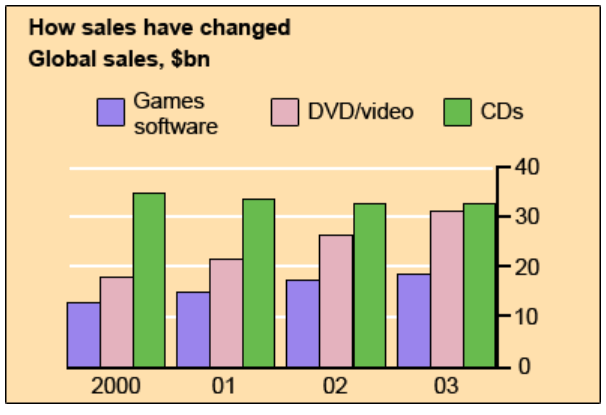
Although the sale prices of the CDS decreased, it remained the same for the year 2002 and 2003.
The sale prices of the CDs decreased in 2001, whereas/while it remained the same in the year 2002 and 2003.
Transitions

- In 1970, the most popular fast food was pizza, over 300 grams were consumed each week. By 1990, however , this had fallen to just over 200 grams.
- There was a vast increase in the consumption of Fish and Chips. In contrast, there was a drop in the consumption of pizza over the years.
- On the one hand, the consumption of hamburgers increased. On the other hand, the consumption of pizza decreased.

- Like Canada, Japan also has a 99% adult literacy rate.
- Canada has more annual income than all the other four countries.
- The adult literacy rate of Zaire is far less than all the other four countries.
- As observed from the given data, daily calorie supply in Canada and Japan was 3326 and 2846 per person, while this ratio in Peru and Zaire was almost half, with 1927 and 1749 per person.
- Initially, the annual incomes of Canadian and Japanese people were much higher than in Peru and Zaire.
- Zaire’s life expectancy is not as high as Canada’s or Japan’s.
- The economic and social living standards of Canadian and Japanese citizens were far better than those of the people of Peru and Zaire.
Using Approximate Data
When you are comparing and contrasting, you don’t usually have the exact numbers, like in the chart below. Thus you use appropriate phrases for comparative data.
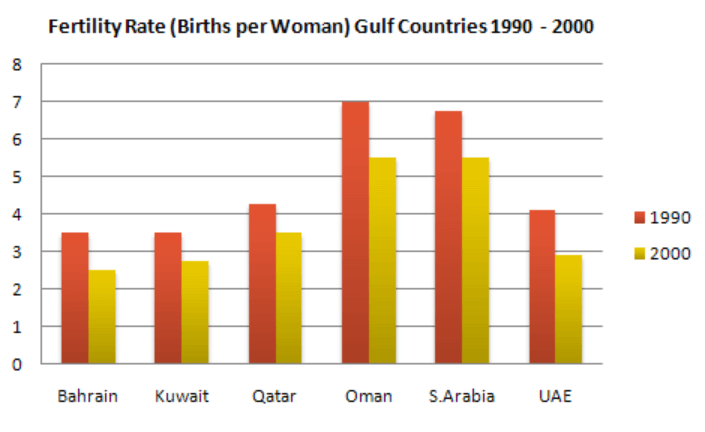
- In 1990, the fertility rate in Kuwait was just over 3.
- In 1990, the fertility rate in Kuwait was approximately 3.
Here you can see that if your value is above the value mentioned and there is no precise number given, you can use ‘just over’ or ‘approximately.’
- In 2000, the fertility rate in the UAE was nearly 3.
- In 2000, the fertility rate in the UAE was almost 3.
Here you can see that if your value is below the value mentioned and there is no precise number given, you can use ‘nearly’ or ‘almost.’
Also check :
- IELTS Writing task 1 tips
- IELTS Writing task 1 Diagram
- IELTS Writing tips
- IELTS Writing recent actual test
- IELTS Writing Answer sheet
- IELTS map vocabulary
- IELTS Writing Task 1 Connectors
Practice IELTS Writing Task 1 based on report types

Start Preparing for IELTS: Get Your 10-Day Study Plan Today!

Explore other Writing Task 1 Articles

Courtney Miller

Nehasri Ravishenbagam

Kasturika Samanta

Post your Comments
Recent articles.

Janice Thompson

IELTSMaterial Master Program
1:1 Live Training with Band 9 Teachers
4.9 ( 3452 Reviews )
Our Offices
Gurgaon city scape, gurgaon bptp.
Step 1 of 3
Great going .
Get a free session from trainer
Have you taken test before?
Please select any option
Email test -->
Please enter Email ID
Mobile Band 9 trainer -->
Please enter phone number
Application
Please select any one
Already Registered?
Select a date
Please select a date
Select a time (IST Time Zone)
Please select a time
Mark Your Calendar: Free Session with Expert on
Which exam are you preparing?
Great Going!

Mastering IELTS Task 1 Comparison Essays: Expert Strategies for Success
IELTS Writing Task 1 comparison essays can be challenging, but with the right strategies, you can excel in this crucial component of the test. This comprehensive guide will provide you with expert tips and techniques …
Written by: IELTS Mentor
Published on: October 20, 2024

Table of Contents
Understanding the Task
Before diving into strategies, it’s essential to grasp what IELTS Task 1 comparison essays entail. These essays typically require you to compare and contrast information presented in charts, graphs, or diagrams. The key is to identify similarities and differences, and present them in a clear, organized manner.
Types of Comparison Essays
- Single chart/graph with multiple data sets
- Two or more charts/graphs with related information
- Before and after scenarios
- Process diagrams with multiple stages
Understanding these variations will help you approach each task with confidence.
Key Strategies for Success
1. analyze the data thoroughly.
Take a few minutes to carefully examine the visual information provided. Look for:
- Overall trends
- Significant similarities and differences
- Highest and lowest values
- Unexpected or unusual patterns
This initial analysis will form the foundation of your essay.
2. Plan Your Essay Structure
A well-organized essay is crucial for scoring high in Task 1. Structure your essay as follows:
- Introduction: Paraphrase the question and provide an overview
- Body paragraph 1: Discuss main similarities
- Body paragraph 2: Highlight key differences
- Conclusion: Summarize the main points (optional for Task 1)
This clear structure will help you present information logically and coherently.
3. Use Appropriate Comparison Language
Employing a variety of comparison expressions will enhance your essay’s quality. Some useful phrases include:
- “In contrast to…”
- “While X shows…, Y indicates…”
- “Both X and Y demonstrate…”
- “X is significantly higher/lower than Y”
Remember to use these phrases naturally and avoid overusing them.
improving coherence in writing task 1

4. Quantify Your Comparisons
When comparing data, be specific and use numbers to support your statements. For example:
“The percentage of internet users in Country A was 75%, which was 25 percentage points higher than in Country B at 50%.”
This precision adds credibility to your analysis and demonstrates your ability to interpret data accurately.
5. Group Similar Information
To make your essay more coherent, group similar data or trends together. This approach allows you to make broader comparisons and avoid repetition. For instance:
“Countries A, B, and C all showed an upward trend in internet usage, while Countries D and E experienced a decline.”
6. Focus on Key Features
In Task 1 essays, it’s crucial to identify and describe the most significant features of the data. Dr. Emily Watson, a renowned IELTS examiner, advises:
“Don’t try to describe every single detail. Instead, focus on the most important trends, similarities, and differences. This approach demonstrates your ability to analyze and prioritize information effectively.”
7. Use a Range of Vocabulary
Expand your lexical resource by using synonyms and varied vocabulary related to trends and comparisons. This not only improves your language score but also makes your essay more engaging. Some examples include:
- Increase: rise, grow, climb, surge
- Decrease: decline, fall, drop, plummet
- Significant: substantial, considerable, notable
- Similar: comparable, analogous, akin to
how to write task 1 with better vocabulary
8. Practice Time Management
With only 20 minutes allocated for Task 1, efficient time management is crucial. Aim to spend:
- 3-5 minutes analyzing and planning
- 12-15 minutes writing
- 2-3 minutes reviewing and editing
Regular practice will help you refine your timing and ensure you complete the task within the given timeframe.

9. Use Examples Effectively
Incorporating specific examples from the data can strengthen your essay. However, be selective and choose examples that best illustrate your points. As Professor Michael Chen, an IELTS preparation expert, notes:
“Effective use of examples shows that you can interpret data accurately and support your observations with evidence. But remember, your goal is to analyze, not just describe.”
using task 1 examples effectively
10. Maintain a Formal Tone
While your essay should be clear and readable, it’s important to maintain a formal academic tone. Avoid colloquialisms, contractions, and overly casual language. Instead, use precise, objective language that reflects the analytical nature of the task.
Common Pitfalls to Avoid
- Overcomplicating your language: Clarity is key in Task 1 essays.
- Neglecting to paraphrase the question: Always rephrase the task in your introduction.
- Providing personal opinions: Stick to the facts presented in the data.
- Using memorized phrases inappropriately: Ensure all language use is natural and context-appropriate.
- Forgetting to proofread: Always leave time to check for errors.
Mastering IELTS Task 1 comparison essays requires practice, strategic thinking, and attention to detail. By implementing these Strategies For Task 1 Comparison Essays , you’ll be well-equipped to tackle any comparison task with confidence. Remember to analyze thoroughly, structure your essay clearly, use appropriate language, and focus on key features. With consistent practice and application of these techniques, you’ll see significant improvement in your Task 1 performance.
how to maximize score in IELTS writing with practice
How long should my Task 1 essay be?
Your Task 1 essay should be at least 150 words. Aim for 170-190 words to ensure you’ve covered all necessary points without being overly wordy.
Should I always include a conclusion in Task 1 essays?
While not strictly necessary, a brief conclusion can help summarize your main points. However, if you’re short on time, focus on the introduction and body paragraphs.
How can I improve my data interpretation skills?
Practice regularly with various types of charts and graphs. Analyze real-world data from reputable sources like government statistics or economic reports.
Is it okay to use personal pronouns in Task 1 essays?
It’s best to avoid personal pronouns like “I” or “we.” Instead, use more objective language to describe the data.
How important is handwriting in the IELTS Writing test?
While content is most important, legible handwriting ensures the examiner can understand your essay easily. Practice writing clearly under timed conditions.
Can I use bullet points or numbered lists in my Task 1 essay?
It’s generally better to write in full paragraphs. Use transitional phrases and cohesive devices to organize your ideas instead of bullets or numbers.
Master IELTS Writing Task 2: Sample Essays and Analysis on the Impact of High Inflation on Real Assets
November 1, 2024
Mastering the Art of Laughter: How to Describe a Hilarious Experience in IELTS Speaking
October 30, 2024
Mastering the IELTS Speaking Task: Describing a Celebrity Encounter
Mastering ielts speaking: how to eloquently describe a festival in your area, mastering ielts speaking: how to eloquently describe a book you couldn’t finish, leave a comment cancel reply.
Save my name, email, and website in this browser for the next time I comment.
About IELTS Mentor
IELTS Essay
Mastering ielts listening: how to improve focus on specific information, mastering ielts: proven strategies for handling tricky passages.
- Skip to primary navigation
- Skip to main content
- Skip to primary sidebar
IELTS Training with Jonathan
Helping Busy People Succeed in IELTS.
How to use compare and contrast language in an IELTS Discussion Essay
By ielts-jonathan.com on 29 January 2021
How certain language improves you IELTS writing score
In the majority of IELTS essays and reports, there will be a need to signpost the direction of your essay.
At other times you will need to compare and contrast ideas from the question and contrast your own response.
In case you were unaware, signposting means showing your reader that the idea or point in your writing is taking a different direction.

This is an important element of a successful IELTS task essay.
Contrasting and comparing are also important in building a strong and logical argument too.
Both of these can add to the coherence of you essay and can make your message much clearer to the examiner.
In this post, I am going to use the following Task 2 question to demonstrate language patterns that compare or contrast topics in an appropriately academic way:
Sample IELTS Question
Some people that reading traditional books is better than reading the same material online. What is your opinion? Discuss both views in your response.
Your own ideas
Obviously we have to have our own ideas which we gain from planning .
Either way, it is obvious from the question that there will be some need to contrast and compare within the scope of the topic which is ‘ reading books online compared or contrasted to physical books ‘.
Here are some comparative linking language examples that will be helpful to the response:
IELTS Comparative Language
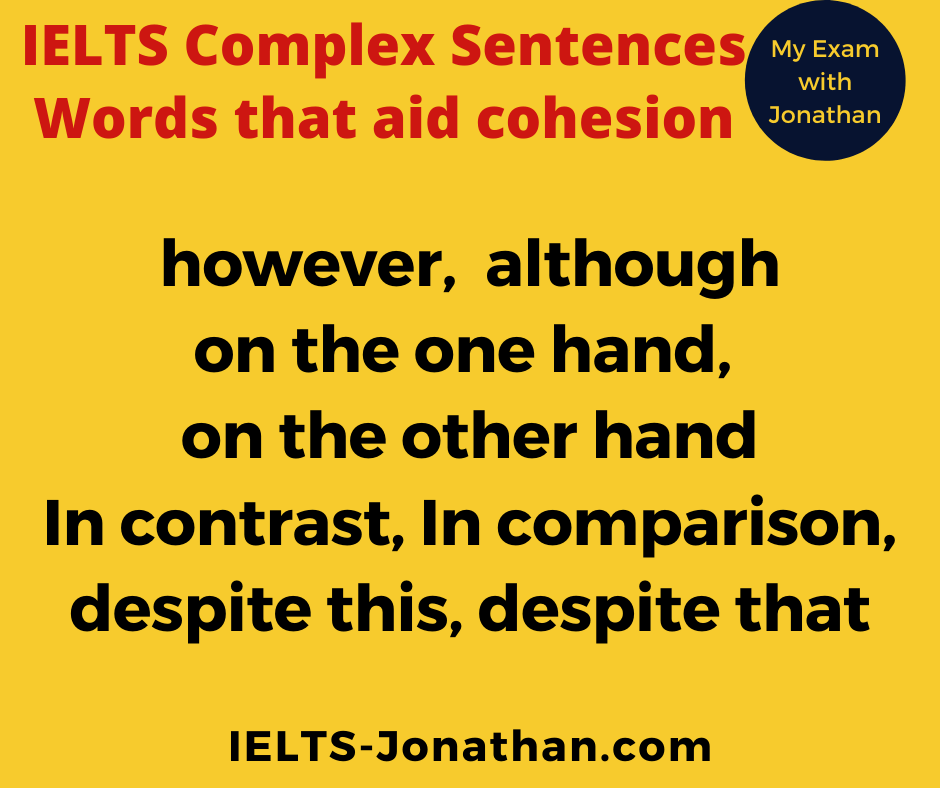
nevertheless
on the one hand / on the other hand
Despite this/ that
In contrast / In comparison
However , for some people, reading in this way is not productive, practical or enjoyable. Reading online nevertheless has its own unique advantages. On the one hand, there seems to be something more tangible with reading a paper book, but on the other hand paper-based books cannot offer the instantaneous access to vast amounts of data and easy of use.
As can be expected, comparative adjectives will also play an important role when comparing and contrasting something with something else.
IELTS Language to Compare

greater capacity
higher engagement
(As in ‘Unlike reading paper books, reading online allows…’)
In many ways, books are more flexible Today’s devices have a higher storage capacity than before This gives the reader a greater choice of when and what to read.
Signposting language or sentence ‘transition’ language helps the essay sequence its comparing and contrasting points.
However, as a writer, I have avoided using some of these in the following essay by using strong topic sentences .
IELTS Language that shows transition

in addition to this
In addition to this , there is little to distract the reader from the enjoyment of reading itself process. Thus , this gives the reader a greater choice of when and what to read. Therefore , an obvious conclusion is based on the personal preference and age of the individual.
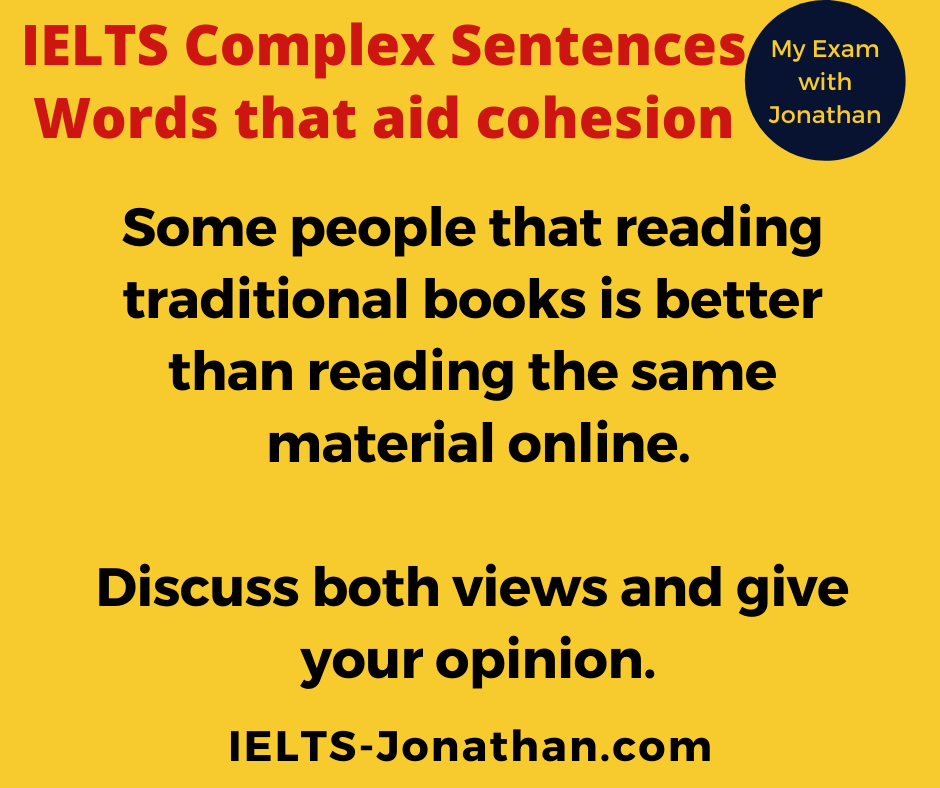
Read the example essay below and see if you can identify some of the above language and examp les.
Any questions, leave a comment at the end for a reply!
Some people believe that reading traditional books is better than reading the same material online. What is your opinion? Discuss both views in your response.
There are both benefits and drawbacks to reading paper-based books and reading online materials using a laptop, phone or computer. This essay will examine both of these areas before reaching a personal conclusion.
The obvious advantage of books is that they can be read anywhere. In many ways, books are more flexible, for example, a book can be read on a train, beach or plane and does not require a Wi-Fi connection or internal storage as a phone does. In addition, for some people, books are more engaging and absorbing than reading materials online. In addition to this, there is little to distract the reader from the enjoyment of reading itself process.
Reading online nevertheless has its own unique advantages. With today’s devices popular with younger people, many books and journals can be stored within a devices’ memory which would normally require at least a bookshelf for storage or would be too heavy to carry in a bag. Thus, this gives the reader a greater choice of when and what to read. However, for some people, reading in this way is not productive, practical or enjoyable. Unless the reader is trained and disciplined, it is easy to be distracted, for example, by social media. Furthermore, research shows that less information is taken in or absorbed when reading online and it also encourages skimming and scanning practices rather than reading the detail. Thus, readers may miss or overlook important points or nuances that can be easily seen when reading paper-back books.
As a conclusion, it seems that there are benefits to both methods of reading. Therefore, an obvious conclusion is based on the personal preference and age of the individual. However, if I were to recommend a certain method, it would be reading paper books due my personal preference of convenience and the enjoyment it brings.
Introduction and Body 1
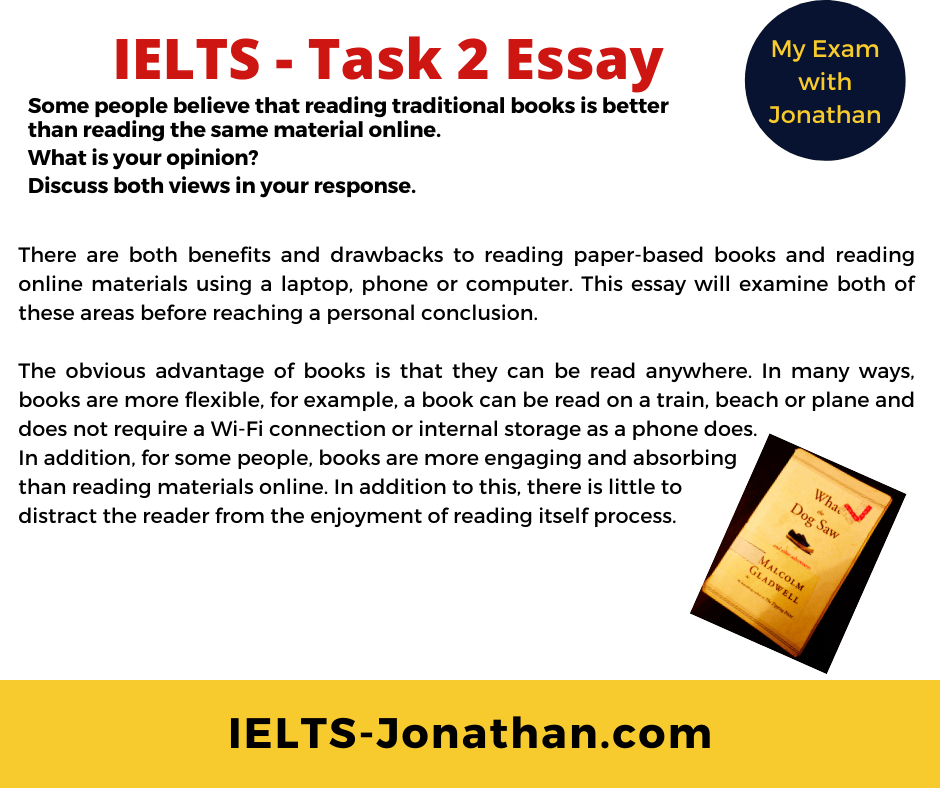
Body 2 and Conclusion
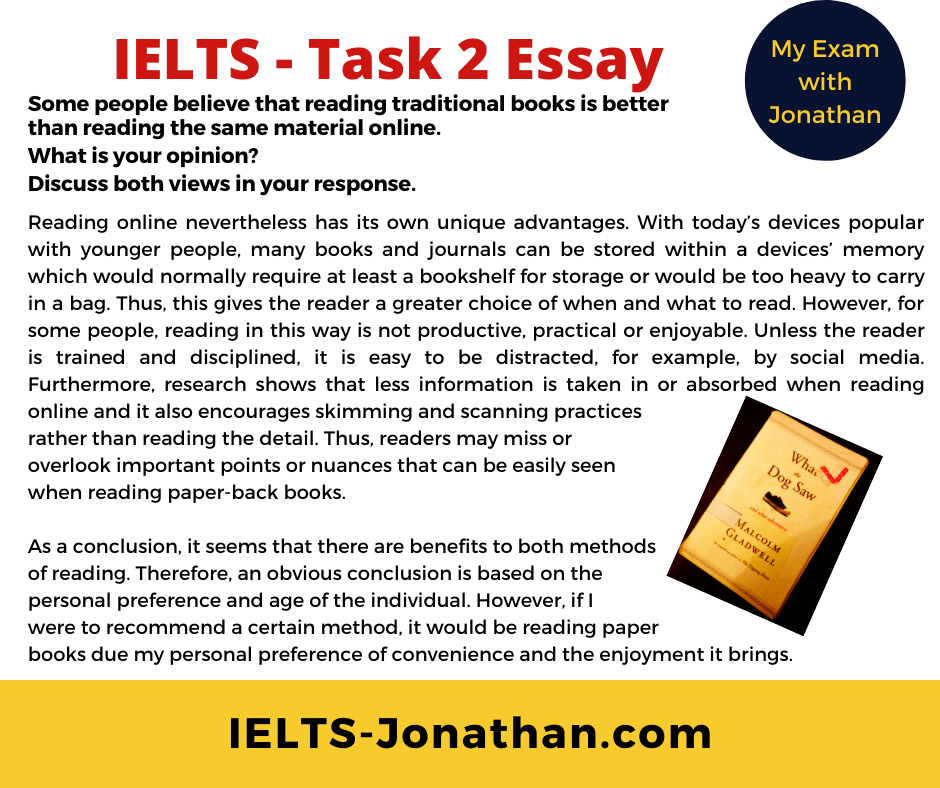
Don’t forget to leave a comment if you have a question.
I’m Jonathan
I’ve taught IELTS and University English in more than a dozen universities and schools around the world.
I’m a parent, traveller and passionate about language teaching and helping students achieve their dreams.
Whilst living in Austria or working in Asia, I run IELTS courses to help students get to where they want to be.
If you are serious about IELTS, connect with me to see how I can help you.

IELTS Writing Posts
The Best Approach to Task 2 Writing
Paragraphing in Task 2 Writing
Strong Arguments for Task 2
Writing the Introduction
Writing a Line of Argument
Cohesion for Task 2 Writing
Writing – Benefits of a Foreign University Education
Share this:
- Click to share on Twitter (Opens in new window)
- Click to share on Facebook (Opens in new window)
- Click to share on Pinterest (Opens in new window)
- Click to share on WhatsApp (Opens in new window)
- Click to share on Telegram (Opens in new window)
- Click to share on Tumblr (Opens in new window)
- Click to share on LinkedIn (Opens in new window)
- Click to print (Opens in new window)
Let me help you get the IELTS Result you need

JUST WRITING FEEDBACK

Speaking Feedback
IELTS TRAINING
IELTS FEEDBACK
YOUR PRIVACY
TERMS AND CONDITIONS
- TOEFL Writing Correction Topics
- OET Mock Tests
- Writing Correction
- Speaking Mock Test
- Reading Course
- Listening Practice Tests
- FREE Practice Tests
- IELTS Writing Correction
- IELTS Speaking Practice
- OET Writing Correction
- OET Reading Course
- OET Speaking Mock Test
- TOEFL Writing Correction
- PTE Writing Correction
- OET Listening Practice Tests
- OET (Occupational English Test)
- PTE (Pearson Test of English)
- Academic Task 1
IELTS Academic Task 1 Compare & Contrast Guide
- Task 1 Guide
- Table & Bar
- Bar & Pie
- Table & Pie
- Compare Contrast
- Identifying Trends
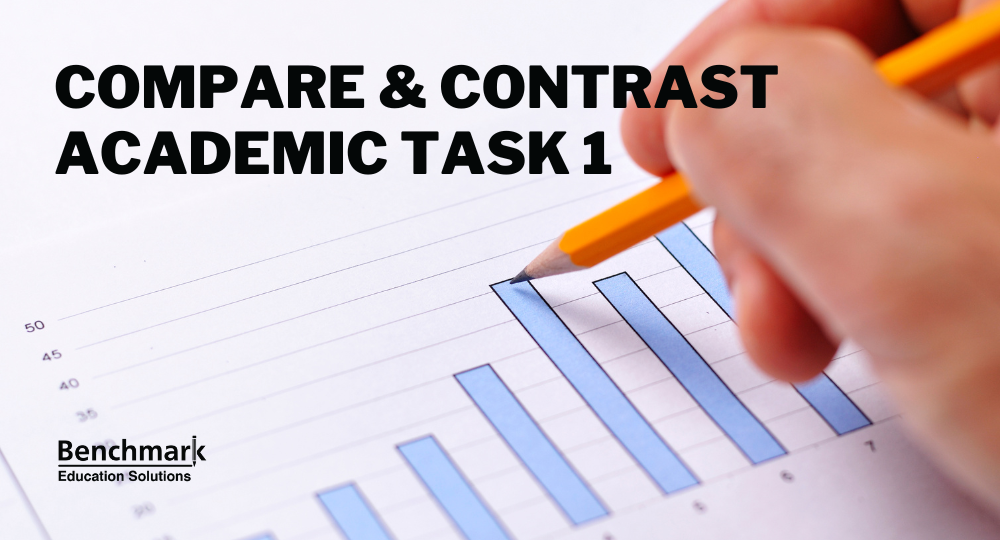
The ability to compare and contrast is important in both the speaking and writing sections of the IELTS exam and can help you to improve your score in Grammatical range and accuracy and Lexical Resource . In this guide, we will look at different grammatical structures and language to help you compare and contrast effectively in the IELTS Academic test.
Table of Contents
1.1 comparatives and superlatives, 1.2 qualifying comparisons, 1.3 comparing similar/opposite figures, 1.4 subordinate clauses, 1.5 transition words, 2.1 adverbs, 2.2 comparing things that are the same/similar, 2.3 unusual vocabulary, 2.4 cohesive devices, 1 comp are and contrast in ielts writing.
One of the aims of IELTS writing task 1 is to compare and contrast information given in a graph , chart or diagram . If you want to achieve a higher IELTS band score, you need to use a range of language and grammatical structures accurately.
One way to compare and contrast is to use comparatives and superlatives .
Let’s quickly look at the rules for how to form comparatives and superlatives:
Here are some examples for the bar chart below:

- Cappuccinos are more popular in Club coffee than Espresso Express.
- Americanos are less popular in Espresso Espresso than Club coffee.
- Cafe lattes are the most popular hot drinks overall.
- Caramel lattes are the least popular beverage in Club Coffee.
Comparatives and superlatives can also be used in any IELTS Writing Task 2 essay , for example:
- In recent years, it has become much more common for students to complete their degree overseas instead of their home country.
- It is argued that regional and community action is more effective than global efforts.
- Having more money and less free time is better than earning less money and having more free time.
IELTS Writing
Ielts writing correction & grading.

Improve Your IELTS Score
- 24-Hour Turnaround
- Open 365 Days
- 1 Year Validity
- Handwritten Essays Accepted

You can also modify your comparative phrases even further. See our examples in bold below:
Americanos were a lot more popular than espressos.
The country’s GDP was much higher in 1992 than 2000.
France produced much less energy than Germany in 2009.
There were slightly less visitors to the UK in 1979 than 1980.
The Children’s charity received far more money in 2016 than 2017.
Encouraging cycling is a far more effective way of reducing pollution than punishing drivers.
NEgative news stories are much more common than positive reporting.
Even if you are given numbers that are almost the same in writing task 1, you can still use comparative language such as:
- almost as … as
- not quite as … as
- nearly as … as
- Just as many cars as vans were hired in 2000.
- The number of people that emigrated to the USA in 2009 was almost as high as the number to the UK.
- The number of vehicle thefts in 2000 was not quite as high as it was in 2001.
- Travelling by bike was nearly as popular as travelling by car in the UK in 2018.
And if you are given figures that are drastically different , you can use the following phrases to create a contrast:
- Not nearly as …. as
- Nowhere near as … as
- half as … as
- The proportion of monthly income spent on entertainment was not nearly as high as housing.
- The percentage of women in poverty of women aged 45-54 was nowhere near as high as women aged 18-24.
- Half as many history books as fiction books were borrowed from the library in 2014 than 2018.
Subordinate clauses are another way to compare and contrast information, as well as increase your grammatical range and coherence in IELTS Writing Tasks 1 and 2
Subordinate clauses joined to the main clause using a subordinating conjunction .
Here are some suitable subordinating conjunctions you could use:
- Even though
- Although going to the gym is good for your health, it is not effective without a balanced diet.
- While English was the most popular subject in 2020, Economics was even more popular in 2021.
- Even though most students pass their exams, many still choose to travel abroad and take a gap year.
Transition words, also known as cohesive devices , are another way to compare and contrast.
Here’s a list of useful cohesive devices to compare and contrast:
- In contrast
- In the same way
- Nevertheless
- On one hand
- On the other hand
- Many actors are often followed by the press. Likewise, reality TV stars often report being hounded by paparazzi.
- One one hand , renting your home instead of buying it can be more beneficial as the landlord is responsible for repairs. On the other hand , you will not be able to pass on the house to your children in the future.
- It is argued that people should eat a plant-based diet rather than eating meat as it is healthier.
IELTS Speaking
Ielts speaking practice.

- One-on-one Zoom Session
- Instant Feedback & Band Score
- Includes Part 1, Cue-card, Part 3
- Exam-based Speaking Topics

2. Compare and Contrast in IELTS Speaking
Comparing and contrasting is not only important in writing but also the IELTS speaking section of the test, especially parts 2 and 3 where you have more time to develop your answers.
You can comparing people, places and things in any part of the speaking exam using the following structures:
- A is similar/different to B because …
- A is similar/different to B in that …
- Modern art is different to traditional art forms because you often need to interpret modern artwork in your own way.
- My hometown is similar to where I live now in that both are busy cities with a great nightlife.
You could also use a range of adverbs such as:
- totally/strikingly/ distinctly different
- slightly/rather/subtly different
- My highschool experience was distinctly different from my time at university.
- My daily routine today is only subtly different from a few years ago.
- It is quite common for people to choose tea over coffee in my country.
Even if you have two things that are similar, you can still use language to highlight the similarities. Here are just some ways you can do this:
- A is as reliable as B
- A is identical to B
- A is the same as B
- Electric vehicles are as reliable as petrol cars.
- The replica of the Eiffel tower in my city is identical to the original in Paris.
- The level of pollution in London is the same as in other large cities.
To increase your range of IELTS vocabulary and your score in Lexical resources, you should try to include more unusual words and phrases in your answers. Here are some examples linked to comparing and contrasting:
- A is a far cry away from B
- A is worlds apart from B
- A and B are poles apart
- A is in a different league to B
- Alaska is a far cry away from Florida, it’s so much colder and far less populated.
- Australia is worlds apart from Berlin, there are so many cultural differences especially when it comes to the food.
- My mother and I are poles apart in personality, she is far more outgoing than I am.
- My brother is in a different league to me when it comes to musical ability, he has been composing songs since a very early age.

As with writing, you can also use cohesive devices or IELTS transition words in the speaking section to compare and contrast, for instance:
- On the contrary
- Children should study art at school because it encourages their creativity. Likewise , they should also be encouraged to take up a musical instrument.
- Governments should take responsibility for the food children eat at school. On the other hand , it could also be argued that students should have the freedom to make their own decisions.
Leave a Reply Cancel reply
Your email address will not be published. Required fields are marked *
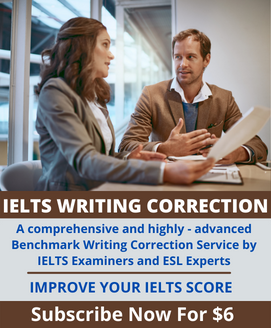
- ielts writing
- ielts listening
- ielts speaking
- ielts reading
- IELTS Sample Reports
- IELTS Sample Essays
- IELTS Vocabulary
- IELTS Grammar
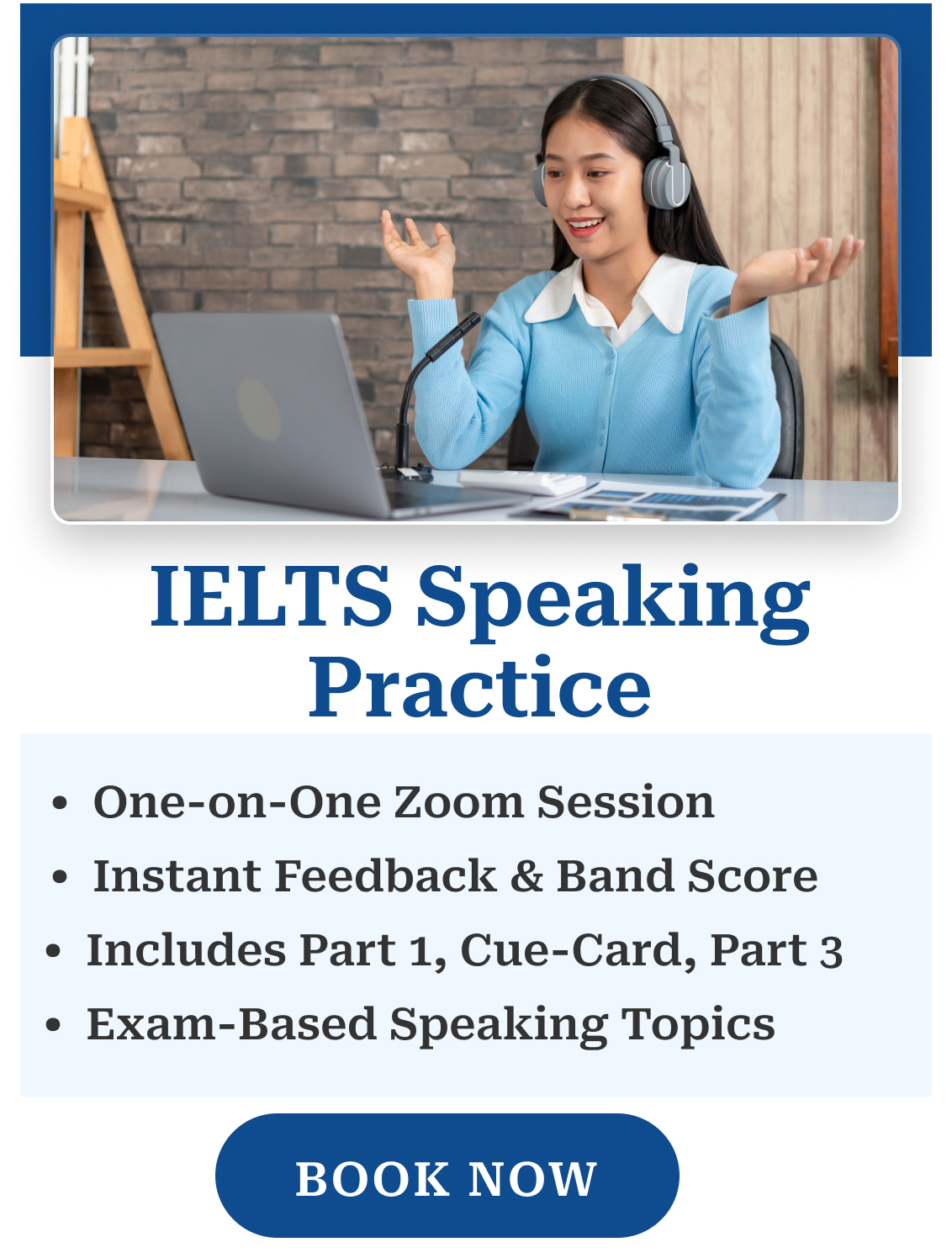
Exam Updates & Tips!
Signup for preparation and special offers!
Please check Inbox/Spam/Junk folder to confirm your email address.

IMAGES
VIDEO
COMMENTS
In ‘compare and contrast’ type of essay, IELTS examiners want you to discuss the points of comparing and contrasting the two things i.e. similarities and differences between the two.
While it can be a little intimidating to approach this type of essay at first, with a little work and practice, you can write a great compare-and-contrast essay for IELTS! I’ve provided some examples useful for comparing and contrasting, and exercises too.
In IELTS Writing Task 1, you are commonly provided with graphs, pie charts, etc. which have data that should be compared and contrasted. In this lesson, you will learn the type of vocabulary that you’ve got to use to compare and contrast information in the graph.
IELTS Writing Task 1 comparison essays can be challenging, but with the right strategies, you can excel in this crucial component of the test. This comprehensive guide will provide you with expert tips and techniques to help you tackle comparison essays effectively and boost your IELTS score.
Essays that IELTS examiners like to read have a strong, coherent and logical argument. An important element of a successful IELTS essay is often contrasting and comparing ideas.
Compare and Contrast in IELTS Writing. 1.1 Comparatives and superlatives. 1.2 Qualifying comparisons. 1.3 Comparing similar/opposite figures. 1.4 Subordinate clauses. 1.5 Transition words. Compare and Contrast in IELTS Speaking. 2.1 Adverbs. 2.2 Comparing things that are the same/similar. 2.3 Unusual vocabulary. 2.4 Cohesive devices.